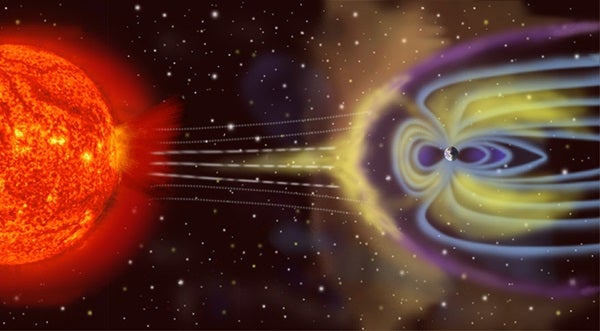More than 60 years ago, a woman with no advanced training in mathematics created a theory about planetary magnetic fields. Her name? Donna Elbert. Her job? A human “computer” working for famed astrophysicist Subrahmanyan Chandrasekhar.
Now, researchers Susanne Horn of Coventry University and Jonathan Aurnou of UCLA are combining Elbert’s work with modern computing power to uncover more about the complex physics that give rise to still poorly understood planetary magnetic fields, or magnetospheres.
The results may help scientists better understand Earth’s own magnetic field, as well as potentially point to exoplanets that could likewise sustain global magnetic fields that are strong enough to protect life.
The new research was published Aug. 10 in Proceedings of the Royal Society A.
The human touch
Computers, at their most basic level, are calculating machines. But before computers sat upon the desks of every researcher and office worker, they took up entire rooms and specialists were required to operate them. And before that, “computers” were human beings who did reams of calculations by hand — or, at best, with a calculator, which is only a minor help when it comes to complex, analytical physics.
The vast majority of these human computers were women. Some had advanced mathematics backgrounds, but many had only high school degrees. The job was usually treated much like a secretarial position, requiring mostly fine attention to detail. While some human computers stuck to rote calculations, more than a few took to the math with superior skill, turning up insights and improvements that showed they had a deep understanding of the theories behind the equations.
One of these particularly talented computers was Donna deEtta Elbert. For more than 30 years, she worked with legendary astrophysicist and Nobel laureate Subramanyan Chadrasekhar, who is most famous for discovering the eponymous Chandrasekhar limit.
This limit refers to the maximum mass a white dwarf can reach before it collapses into a black hole. (A white dwarf is the dense remnant leftover after the normal life of a Sun-like star ends.) Chandrasekhar was ahead of his time, too. When he published his namesake limit, the very existence of black holes was still in doubt. For many years, his prediction was seen mostly as a mathematical quirk, unlikely to have much bearing on the real world.
Elbert was originally brought on as Chandrasekhar’s computer, but she rapidly became an integral part of his research process. Elbert shares publication credit with Chandrasekhar on multiple papers, and he references her in the footnotes of many more.
Today, anyone contributing as much as she did to Chandrasekhar’s work would be listed as a coauthor and treated and credited as a full fellow researcher. But in the 1950s, Elbert was simply seen as a computer.
“He wasn’t taking her work,” Horn notes about Chandrasekhar. “He really tried to give her credit. It was just in the time of the 50s.”
Magnets: It’s complicated
Elbert and Chandrasekhar worked on many different topics during their long professional partnership. And in the early 1950s, they were focused on the complex magnetic fields of planets.
Every planet rotates, or spins, causing the Coriolis effect, an inertial force that deflects everything from air and water to missiles. Its strength depends on how quickly a planet spins. A fast-rotating planet like Jupiter, where one day is only 10 hours long, has a very strong Coriolis effect. You can see the effects in the broad and visible bands in Jupiter’s atmosphere. Meanwhile, a slowly rotating planet, like Venus, which spins around only once every 243 days, has almost no Coriolis effect or banded appearance.
Magnetic fields arise from moving, charged particles, and Earth has a liquid metal core. Other planets have salty oceans. When these materials churn, they create magnetic fields, which then exert forces on the particles within them.
Many planets with warm or wet interiors, Earth included, also experience convection. This phenomenon is seen in the motion of a lava lamp, where warm material rises upward, cools, then falls down to be heated again.
Together, these factors result in a complicated sloshing and swirling within planets with partially liquid interiors. And because the movement of Earth’s liquid metallic core creates its magnetic field, the field itself is complex — far more so than the standard Earth-as-a-bar-magnet illustrations imply.
Elbert was working with Chandrasekhar when she first noticed that if the strengths of the rotation and magnetic fields are roughly equal, then convection pockets tend to organize into neat, large-scale patterns instead of smaller, more turbulent ones. This is the “sweet spot” that lets a world host a strong, global magnetic field like we see on Earth.
Earth’s magnetic field is responsible for the brilliant northern and southern lights. But more importantly, it protects Earth’s surface and atmosphere from harmful radiation, making life possible.
Scientists know what causes simple magnetic fields. And they know that Earth has a large, complex magnetic field. But there’s still a large gap in their ability to mathematical detail exactly how Earth’s magnetic field forms and behaves. And scientists are always looking to close those gaps in understanding. It’s just that sometimes it takes a long time.
New life for Elbert’s old theory
Horn has been studying magnetic fields her whole career, but Elbert’s prior work only first came to her attention a few years ago. Horn says Chandrasekhar’s textbook on magnetic fields is required reading in her field. “But no one actually read the footnote,” Horn says. “At least no one I talked to.”
The footnote in question isn’t a vague thanks to Elbert for cranking through math that would make a grown physicist weep. Instead, it specifically credits her with the insight about when magnetic and rotational forces match up. Despite this observation sitting in plain sight for decades, it took a long time before scientists could apply it.
Rotation, convection, and magnetism harmonize in subtle ways that defy a straightforward algebraic description or cartoon illustration. The only way forward is analytics, cranking through complex math a speeds only feasible within the last decade or so, according to Horn. Before that, scientists had to choose rotation or convection, or take other simplifying measures. The computing power needed to capture the more complicated physics Elbert put forth just wasn’t available yet.
But now, armed with new computing power and methods, Horn and Arnou returned to Chandrasekhar and Elbert’s decades-old work. They termed that scenario the Elbert range, and they are planning two more papers expanding on her original observations.
Horn says, “The most impressive part is that she didn’t have a university degree. She did tough math that would be hard for me.”
Unfortunately, Elbert died in 2019 at the age of 90. Horn never spoke to her personally. But after bringing Elbert’s work to light, one of her relatives contacted Horn. They said Elbert would be thrilled to see her work and name achieving such recognition. And Horn calls that one of the proudest moments of her career.
“That’s better than research,” she says.











